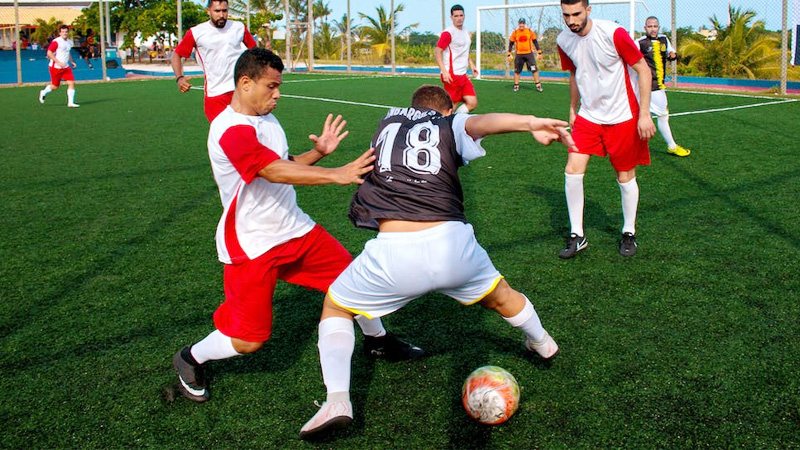At its core, soccer is a delicate balance between offensive ingenuity and defensive resilience, where strategic maneuvers can turn the tide of any match.
In this comprehensive article, we delve into the intricacies of soccer offensive and defensive strategy, exploring the tactics utilized by teams and players to gain a competitive edge on the pitch.
Offensive strategy in soccer revolves around artful ball possession, intricate passing patterns, and devastating attacking plays that unlock rival defenses.
We examine the various formations, from traditional to modern, and analyze the role of key positions, such as strikers, midfield maestros, and creative wingers.
On the flip side, defense in soccer is an art in itself, requiring cohesion, communication, and unyielding determination. We uncover the secrets behind compact defensive setups, pressing tactics, and the critical skill of ball recovery.
Soccer Offensive and Defensive Strategy
Join us on this enlightening journey as we unravel the dynamic strategies employed in soccer’s offensive and defensive play, providing readers with a deeper appreciation of the tactics that shape the outcome of the world’s most beloved sport.
Soccer Offensive Strategies
Successful offensive strategies can significantly impact the outcome of a game, leading to exhilarating goals and memorable victories. Developing a cohesive and dynamic offensive game plan requires a blend of tactical awareness, creativity, and individual skill.
Here, we will delve into some of the most effective soccer offensive strategies used by top teams and players worldwide, enabling them to dominate the pitch and deliver an exciting display of attacking prowess.
Possession-Based Play
Possession-based soccer involves maintaining control of the ball for extended periods, forcing the opposition to chase, and creating openings in their defensive structure.
This strategy emphasizes fluid passing, movement off the ball, and patience in the build-up. Teams employing this style focus on keeping the ball away from the opposition and waiting for the right moment to exploit defensive weaknesses.
Counter-Attacking
Counter-attacking is a lethal offensive strategy, particularly useful for teams with explosive speed and quick transitions. In this approach, a team allows the opponent to have possession and focuses on staying organized defensively.
When they win back the ball, they launch a rapid, direct attack, catching the opposition off-guard and exploiting the spaces left behind.
High Pressing
The high pressing strategy is all about putting relentless pressure on the opponent when they are in possession, particularly in their own half. This tactic aims to win the ball back quickly and high up the field, giving the attacking team an excellent opportunity to create chances in or around the penalty area.
However, high pressing requires immense fitness levels and coordination among players to avoid leaving gaps in the defense.
Overload and Width
Creating overloads and utilizing width is a fundamental attacking strategy. By shifting play to the wings, teams can stretch the opposition’s defense and create gaps in the middle for players to exploit.
Overloading a specific area of the pitch with multiple attacking players creates numerical superiority, which can lead to better passing options and increased goal-scoring opportunities.
Tiki-Taka
The Tiki-Taka style of play gained immense popularity through the success of FC Barcelona and the Spanish national team. This strategy involves short, quick passes and constant player movement to retain possession and tire out the opposition.
Tiki-Taka is a patient approach, focusing on wearing down the opposition’s defense until an opening appears for a decisive attack.
Long-Ball Game
The long-ball game relies on precise long passes from the defense or midfield to bypass the opposition’s defensive lines and directly target forwards or attacking players.
This strategy can be highly effective when a team has strong aerial players and pacey forwards who can chase down long passes, creating goal-scoring opportunities from relatively deeper positions.
Set-Piece Specialization
Effective set-piece execution can be a game-changer in soccer. Teams often practice specialized routines for corner kicks, free-kicks, and throw-ins to catch the opposition off-guard and capitalize on scoring opportunities. A well-rehearsed set-piece strategy can turn tight matches in favor of the team that executes them better.
Soccer Defense Strategies

A strong defensive strategy can neutralize even the most formidable attacking teams and provide a solid foundation for counterattacks and goal-scoring opportunities.
In this section, we will explore some of the key defensive strategies employed by soccer teams to maintain their shape, thwart opponents, and emerge victorious on the pitch.
Organized Formation
A well-organized defensive formation is the backbone of any successful soccer team. The most common defensive formations include the 4-4-2, 4-2-3-1, 3-5-2, and 5-3-2, among others. The choice of formation depends on the coach’s tactical preferences, the team’s strengths and weaknesses, and the style of play of the opponents.
A solid defensive formation emphasizes compactness, maintaining proper positioning, and preventing gaps between defenders. The backline should work in cohesion with the midfield and forwards, creating a seamless transition from defense to attack.
Pressure and Pressing
Pressuring the opponent in their own half is a key aspect of modern soccer defensive strategies. The objective is to win back possession quickly and disrupt the opposing team’s build-up play. Effective pressing requires players to be highly coordinated, maintaining pressure on the ball carrier while covering passing lanes to limit options.
Teams often use triggers to initiate pressing, such as when the ball is played to a certain zone or player. The pressing can be done as a team or in smaller groups, depending on the coach’s philosophy and the tactical situation.
Zone Defense
Zone defense involves players defending specific areas of the field rather than marking individual opponents. Players in each zone collaborate to close down spaces, mark potential threats, and block passing lanes.
Zone defense allows teams to maintain their shape and can be particularly effective against teams that rely heavily on individual brilliance.
However, zone defense requires strong communication and understanding among defenders, as players need to pass on attackers to teammates when they enter their designated zones.
Man-to-Man Marking
While zone defense is popular, man-to-man marking is another widely used defensive strategy. In man-to-man marking, defenders are assigned specific opponents to track throughout the game.
This approach can be effective against teams with strong individual players and requires defenders to stay close to their assigned players, limiting their impact on the game.
Man-to-man marking can be risky if defenders are easily drawn out of position or lose track of their assigned players. Therefore, it requires a high level of discipline and defensive awareness.
Counter-Pressing and Transition Defense
Counter-pressing, also known as “Gegenpressing,” is a defensive strategy that involves immediately pressing the opposition after losing possession. The goal is to win the ball back quickly and capitalize on the disorganization of the opposing team during the transition from attack to defense.
In transition defense, the team quickly regains its defensive shape after losing possession, making it difficult for the opposition to exploit the momentary vulnerability. Quick transitions can catch opponents off guard and prevent them from launching dangerous attacks.
Why Are Soccer Offensive and Defense Strategies Important?

Soccer offensive and defensive strategies are essential because they play a crucial role in determining the outcome of a match. These strategies are carefully planned and executed by coaches and players to achieve specific objectives during the game.
Here are some reasons why offensive and defensive strategies are important in soccer:
Scoring Goals and Winning Games
The primary objective of any soccer team is to score goals and win matches. Effective offensive strategies help teams create scoring opportunities, penetrate the opponent’s defense, and convert chances into goals.
Conversely, solid defensive strategies aim to prevent the opposition from scoring, maintaining clean sheets, and ultimately giving their team a chance to win.
Control of the Game
Soccer is a dynamic sport with constant changes in momentum. Having well-structured offensive and defensive strategies allows teams to control the flow of the game.
A strong offense can keep the ball in the opponent’s half, maintain possession, and put pressure on their defense. A solid defense can disrupt the opposition’s attacking efforts and regain possession quickly.
Adapting to Opponents
Different opponents have unique playing styles, strengths, and weaknesses. Soccer strategies are not one-size-fits-all; they need to be adapted based on the opposition.
Coaches study their opponents to identify patterns and vulnerabilities, and then they devise strategies to exploit those weaknesses while minimizing the risks.
Team Cohesion and Communication
Effective strategies require a high level of team cohesion and communication. Players need to understand their roles, responsibilities, and positioning on the field during both offensive and defensive phases. This understanding fosters better teamwork and improves overall performance.
Minimizing Mistakes
Having a clear game plan helps reduce individual errors and confusion during matches. Players know where to be and what to do in different game situations, reducing the likelihood of making costly mistakes.
Mental and Psychological Impact
Soccer is not just a physical sport; it’s also highly psychological. Well-executed offensive plays can boost a team’s confidence and morale, while a strong defense can frustrate opponents and create doubt in their minds. The psychological aspect of the game can influence the outcome significantly.
Adaptability during Matches
While pre-game strategies are crucial, in-game adjustments are equally important. Coaches and players need to be able to adapt quickly to changing circumstances during a match.
This flexibility allows teams to respond to unexpected situations, capitalize on emerging opportunities, or shore up vulnerabilities.
Entertainment and Fan Engagement
Soccer is a popular spectator sport worldwide, and fans expect an exciting and competitive game. Well-thought-out offensive strategies can lead to entertaining attacking plays and goal-scoring opportunities.
On the other hand, strong defensive tactics can create tension and excitement as fans watch their team fend off the opposition’s attacks.
FAQs
What is a common offensive strategy in soccer?
A common offensive strategy in soccer is “possession-based play.” This approach involves maintaining control of the ball, building up play patiently, and creating goal-scoring opportunities through precise passing and movement.
How do teams effectively counter strong offensive opponents?
To counter strong offensive opponents, teams often employ a defensive strategy known as “low-block defending.” This involves compacting the defensive lines, denying space behind the defense, and focusing on quick counterattacks to exploit gaps left by the attacking team.
What is the primary objective of pressing in soccer?
The primary objective of pressing in soccer is to win back possession quickly. Players apply pressure on the ball-carrier and nearby opponents, disrupting the opposition’s build-up play and forcing turnovers in advantageous positions.
Which defensive strategy relies on players marking specific opponents?
The defensive strategy that relies on players marking specific opponents is “man-to-man marking.” In this approach, defenders are assigned to mark individual attackers, closely tracking their movements throughout the match to limit their impact on the game.
What is the primary objective of soccer defensive strategy?
The primary objective of soccer’s defensive strategy is to prevent the opposing team from scoring goals by maintaining a well-organized formation, pressing, and limiting the space and passing options for the opponents.
Bottom Line
As we conclude our exploration into the captivating world of soccer’s offensive and defensive strategy, it becomes clear that this sport is far more than just a game; it’s a symphony of intellect, skill, and passion.
From the scintillating attacking maneuvers that leave fans in awe to the resolute defensive fortresses that withstand relentless pressure, soccer exemplifies the essence of competitive sport.
In essence, soccer’s offensive and defensive strategies embody the core of teamwork, discipline, and adaptability. As the sport continues to evolve, we can only anticipate new tactics and styles emerging, enriching the game further.
So, as fans cheer for their favorite teams and players, and coaches devise innovative strategies, one thing remains certain – soccer will forever captivate our hearts with its magic, uniting people from all walks of life under the banner of the beautiful game.







